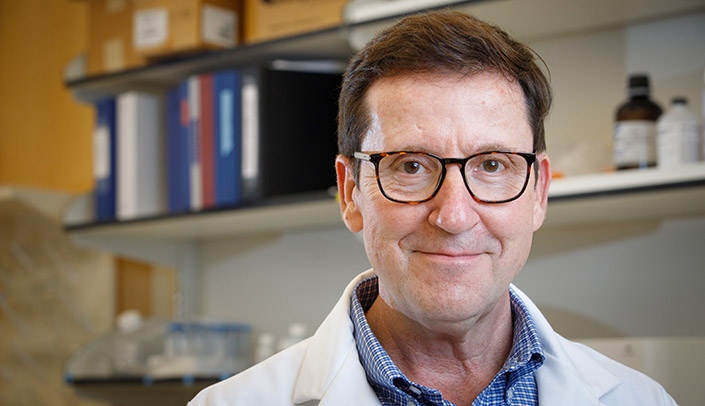The Genomics Core turns 20 this year, and director Jim Eudy, PhD, has been with it every step of the way.
Today, the core offers a variety of services to users, including next generation DNA sequencing (NGS), NanoString technology for profiling panels of genes, single cell genomics and Sanger sequencing. In 2020 alone, the core provided services to approximately 167 different laboratories at all University of Nebraska campuses, as well as other academic research institutions throughout the state.
In 2001, the core was created in response to the development of DNA microarrays, which allowed researchers to measure the activity of many different genes in the genome simultaneously.
“That was a big technological advancement for the study of genetics,” Dr. Eudy said. “There are approximately 22,000 genes in the genome — so being able to measure the gene activity levels in those individual genes simultaneously was a major breakthrough.”
UNMC recognized the implications, and the core — originally housed at the Munroe-Meyer Institute — was created. Initial funding came from the Nebraska INBRE Project, which purchased the core’s first DNA microarray machine and has been a longtime supporter of the core, and the Center for Molecular Human Genetics at MMI. (Shelley Smith, PhD, and her Centers for Biomedical Research Excellence grant also provided important early support, Dr. Eudy said.)
“Like many of our cores, this core’s growth and ability to continue to evolve to meet customer needs also has received critical support from Nebraska Research Initiative funding,” said Tess Kuenstling as Director of Research Resources.
As DNA sequencing technology advanced, the center’s capabilities grew, and, in 2004, the core merged with the UNMC Department of Genetics, Cell Biology and Anatomy, eventually moving to the Durham Research Center.
With the development of DNA microarray technology, increased statistical analysis of data was needed. Dr. Eudy credits UNMC’s biostatisticians, particularly Lynette Smith, PhD, with helping researchers maximize the impact of the newly available data.
Next generation DNA sequencing (NGS) began in 2010, with funding Dr. Eudy obtained from a National Institutes of Health grant purchase of an “Illumina Genome Analyzer IIa,” and the hiring of Alok Dhar, PhD, who was key in integrating the Illumina’s capabilities into the core’s services.
“Next generation sequencing revolutionized what was possible in genetics on a global scale,” Dr. Eudy said, adding that applications included not only humans and other animals in the context of health and disease, but plants in the context of agriculture and conservation.
“At the medical center, we focused on biomedical research,” he said. “But when we worked with colleagues at the University of Nebraska-Lincoln, we worked with plants and agricultural systems and the landscape of what was possible changed.”
With the arrival of NGS, the first genome-wide RNAseq experiments began immediately along with large scale DNA sequencing applications. Again, interdepartmental collaboration was key.
“The datasets generated by NGS are quite large, and the analysis often requires coding and a great deal of computational understanding,” Dr. Eudy said. “As the genomics core was bringing on the NGS technology, UNMC was investing in and developing its bioinformatics infrastructure.”
Today, the genomics core collaborates with UNMC’s Bioinformatics and Systems Biology Core, directed by Babu Guda, PhD, to provide analytical support to researchers who utilize the NGS technology in the genomics core
“Since 2010, the field of NGS has grown tremendously, as has the sequencing technology and the applications,” Dr. Eudy said. “Initially, around 10 to 15 researchers accessed the NGS services annually. Today, the core provides services to approximately 160 different laboratories throughout the state of Nebraska, and approximately 90 of those researchers are accessing the NGS component of the lab.”
Research includes infectious disease, cancer, vision, cardiology, pulmonary and agriculture studies. Going forward, Dr. Eudy expects to see advances that impact personalized medicine, liquid biopsies to identify cancer and more.
“The advancement in technology is amazing,” Dr. Eudy said, reflecting on 20 years. “I’m not sure many people would have foreseen how profoundly different it would be today.”
But the success of the core also is due to its people, said Jennifer Larsen, MD, vice chancellor for research at UNMC.
“While cores depend in part on their advanced technologies, their success depends not only on their leadership but the considerable expertise of the staff in the core, as well,” Dr. Larsen said. “They not only help investigators achieve the best scientific results, but play an important role in the education of our graduate and other students, as well.”

Congratulations Jim! Twenty years is a great accomplishment.
Congratulations Dr. Eudy!!
What a wonderful success story, Jim! Congratulations!
Congratulations Jim! You and your team are always a pleasure to work with. Thanks for all your help over the years.
Congratulations Jim!
Congratulations Jim for building and leading a valuable Core! Really appreciate what your Core offers to UNMC and the NU campuses in general.
Congratulations Jim!
Congrats, Jim!
We are fortunate to be next door to your core and certainly it is our pleasure to know, and to work with, the talented & dedicated team members of your core, Jim! Publishing of several landmark CRISPR papers from our core was possible because of the high quality services offered by your core. Thank you and Congratulations!
Wonderful work, Jim! You built this core from the ground up, and it has been critical to the growth of research at UNMC and in the region. Amazing to think it has been 20 years!